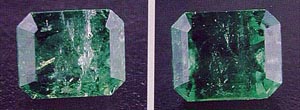Fracture Filling of Gems
Fracture filling is the filling of surface-breaking cavities or internal fractures with some foreign substance to improve a gem's appearance. Literally thousands of products are used to fill fractures in gems. They range from complex proprietary formulas to 3-in-1 oil.

Emerald before & after Fracture Filling
The effect of fracture filling is dramatic. Disturbances that mar the entire stone, making it quite unattractive overall, seem to vanish. The enhancement makes the gem much more appealing to the naked eye and greatly increases its (apparent) value.
Fracture filling can be done on virtually all types of gemstones — diamonds, emeralds, sapphires, rubies, and others. The treatment is easy and inexpensive. It disguises a flaw, making an inferior gem look clearer and more valuable, but the flaw can readily be seen under a microscope
Fracture Filling Emeralds
The Gemological Institute of America (GIA) is currently studying the effects of fracture filling on emeralds. Of the thousands of materials in use, they are concentrating on the 39 most popular ones! They've had to wade through confusing terms and patented ingredients. In some cases, they report, it is not possible to identify a filler because artificial resins can mimic natural ones and a mixture of fillers can conceal the features of the ingredients.
Identifying fillers is only the first step of the GIA study. The GIA's next investigation is more important to consumers: determining the durability and stability of the fillers. However, knowing the durability of a filler is relevant only if you know a filler has been used ã that is, if the retailer has disclosed the treatment in the first place.
In one legal case, a consumer brought suit against a retailer for selling a ring with a fracture-filled emerald as though it were an untreated, high quality gem. Some time after the sale the stone showed damage and the purchaser filed an insurance claim. The insurer had the stone examined in a gem lab and found it to be fracture-filled. The insurer refused to pay the claim, and in turn sued the retailer, arguing that the policyholder should have been informed that the stone was filled with some foreign material and that such a treatment might not be permanent.
The original retailer insisted that the emerald he sold was a high quality, untreated gem. He said the stone must have been damaged subsequently, perhaps when the ring was sized, and then fracture-filled to conceal the damage. The case became a battle of expert witnesses and hinged on responsibility for disclosure of the fracture-filling treatment. Ultimately, the plaintiff won a quarter-million-dollar judgment and the retailer went bankrupt.
